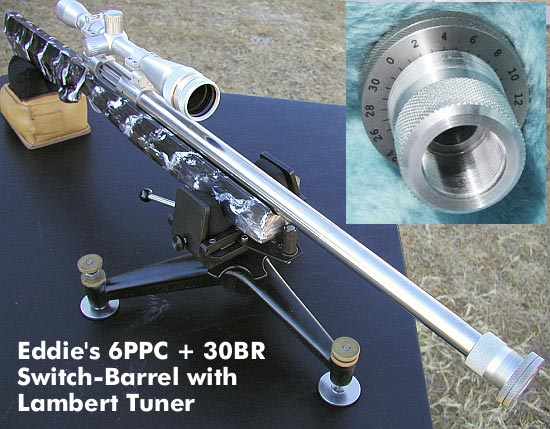Centerfire Benchrest Shooters Explore Benefits of Tuners
Barrel tuners have been used successfully in rimfire benchrest for many years (see photo below). While there are competing theories as to how and why barrel tuners work on rimfire rifles, there is no question that the accuracy of some rimfire barrels can be improved with the addition of a tuner. By changing the position of weights at the end of the barrel, we’ve seen shooters shrink their average group size as well as adjust the “sweet spot” for different lots of rimfire ammo. On the other hand, tuners can be the source of great frustration; some installations may yield little or no benefit. A shooter may have to experiment with a variety of different tuner designs (and weights) to find the optimal configuration.

 Centerfire Tuners–Still a Work in Progress
Centerfire Tuners–Still a Work in Progress
In centerfire benchrest competition, the vast majority of competitors do not use tuners, though a few short-range shooters such as Gene Bukys and Jackie Schmidt have enjoyed considerable success. Gene has won major championships with tuned rifles. In 2011 Gene won both the Super Shoot and World Benchrest Championship (WBC), and Gene recently set a new NBRSA Sporter Class Grand Agg Record.
Centerfire benchrest guns typically employ shorter barrels with a much fatter contour (larger diameter) than rimfire rifles. Because centerfire rounds produce much higher pressures and velocities that a 22LR, a centerfire barrel also exhibits much different vibration characteristics than a typical rimfire barrel. Nonetheless, there are pioneers working with centerfire tuners who believe that tuning may be the “next leap forward” in centerfire accuracy.

Shown below is a switch-barrel benchrest rifle built by Forum member Eddie W. of Texas. It features a dual-port Hall “M” action with a ShadeTree Engineering Tuner crafted by Butch Lambert. The gun is designed to take both a 6PPC barrel for group shooting and a 30BR barrel for score shooting. The gun was barreled by Wayne Shaw, and Eddie did the stock work himself. Eddie reports: “It is a very accurate rifle.”

Will we see more tuners on centerfire rifles? Only time will tell. Some folks believe that, since one can easily adjust the loads shot by centerfire guns (by tinkering with the powder charge and seating depth), tuners have limited utility. On the other hand, tuner advocates such as Gene Beggs believe tuners can help keep your group sizes small even as conditions (temperature, humidity) change. Gene believes that, with an appropriate tuner, you can spend less time fiddling with the load specs (changing your powder charge) and instead “dial in” your sweet spot using the tuner.

Similar Posts:
- Tuning Barrels for Enhanced Precision and Accuracy
- Gene Bukys Sets New Sporter 100/200 NBRSA Grand Agg Record
- Tuner Basics: Guide to Selection and Use of Barrel Tuners
- Tech Tip: Pros and Cons of a Barrel Tuner
- SHOT Show Report: Adjustable barrel weights from AirForce
Tags: Barrel Tuner, Benchrest, Gene Beggs, Gene Bukys, tuner, Vibration


















The most successful CF tuner shooter, Gene Buckys, sets his tuner in the middle of a node, locks it, and never again moves it, preferring to tune by “normal” methods, used by shooters who do not use tuners, adjusting loads as needed, loading between individual matches.
I think that this is an important point to make, because it is counter to the impression that many have that use of a tuner for CF applications would introduce another variable that would over complicate finding and maintaining tune.
My guess like everything else in the competition world is if a few big matches are won and records are broken with them they will become the next must have item if the amount of items currently for sale is any indication lol.
And you are happy with your ddevice? Please gentlemen, do not sing me the mass and you don’t need to wriggle your bottom to evacuate straight but I think the whole issue was settled once and for all by the Frogs with their outstanding FR-F1 and F2 sharpshooter rifles using a combination of barrel tuning device and indexed 3 vent or 4 vent flash hider (depending on the number of grooves in the barrel)
USRA which was the property of GIAT, the French military weapon conglomerate, went on to build a few thousands Winchester 70 rifles with the notorious BOSS device that was a crude attempt to bypass the French patent with less efficiency.
No use reinventing the wheel.
Peter
Here is a link to that rifle specs:
http://fr.wikipedia.org/wiki/FR-F1
Say Pieter, are there many of those fr rifles still in use? I heard that you guys in Europe tend to stick to your hardware for decades whereas we’d rather phase out stuff in pristine condition instead of getting to know its limitations. The fr are supposed to be the very best sniper tools in some circles, aren’t they a little light for that purpose? Some Austrian axes use the kind of devices that you describe. Haven’t seem any, though.